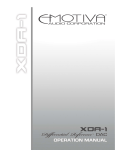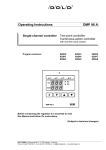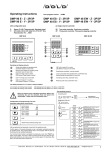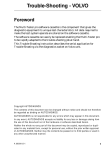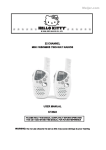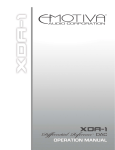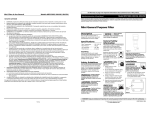Download Operating Instructions DMP 96 C Multi-channel
Transcript
Operating Instructions DMP 96 C Multi-channel controller Program version: Two-point controller 11535 1 2 °C 3 4 5 °C 6 7 Scan 1 2 3 Static ∗ P Tune Start 5 6 Stop 4 Read and observe these operating instructions before commissioning the unit (particularly the notes on installation, assembly and commissioning instructions). Subject to technical and functional change Dold GmbH, D70736 Fellbach, Blumenstr.33, Phone +49(0)711 95152-0, [email protected], www.dold-regler.de DOLD GmbH Operating Instructions DMP 96 C Index: 1. The installation of the unit: .................................................................................. 3 1.1 General: ........................................................................................................................................3 1.2 Please note during installation: .....................................................................................................3 1.3 Identification plate: ........................................................................................................................4 1.4 Terminal connection diagram:.......................................................................................................5 1.5 Mechanical data: ...........................................................................................................................5 2. Inputs, technical data: .......................................................................................... 5 2.1 Inputs channel 1 to channel 4: ......................................................................................................5 2.2 Possible inputs channel 1 to channel 4: .......................................................................................5 2.3 Logic inputs ...................................................................................................................................6 2.4 Technical data of the inputs: .........................................................................................................6 2.4.1 Error-handling at inputs:.............................................................................................................6 3. Controller character:............................................................................................. 7 4. Outputs: ................................................................................................................. 7 4.1 Potential-free relay contacts: ........................................................................................................7 4.2 Logic outputs (optional):................................................................................................................7 4.3 Output responses in cases of error:..............................................................................................7 4.4 Optional analogue outputs (only valid for optional plug in PCB "C"): ...........................................8 5. Auxiliary power: .................................................................................................... 8 6. Display: .................................................................................................................. 8 6.1 Upper 7-segment display: .............................................................................................................8 6.2 Lower 7-segment display: .............................................................................................................9 6.3 LED's:............................................................................................................................................9 7. Operation: .............................................................................................................. 9 7.1 The Different levels: ....................................................................................................................11 7.2 Operation level: ...........................................................................................................................12 7.3 Extended Operation level:...........................................................................................................13 7.3.1 Unlocking the limit contacts: ....................................................................................................14 7.4 Configuration level: .....................................................................................................................14 7.5 Parametrication level: .................................................................................................................17 7.6 Self-tuning: ..................................................................................................................................21 7.6.1 Monitoring the optimization process: .......................................................................................22 8. Line Balancing, Zero Point Correction:............................................................. 23 9. Error and Faults: ................................................................................................. 23 9.1 List of possible error messages (display): ..................................................................................23 10. Program version: .............................................................................................. 23 11. Immunity: ........................................................................................................... 25 Supplement A: The serial interface (RS 485) (only for units with serial interface RS-485). Version: 115 35E115B 07.doc Date: 08/2007 No. of pages: 25 2 DOLD GmbH 1. Operating Instructions DMP 96 C The installation of the unit: 1.1 General: The unit DMP 96 C is a microprocessor controlled multi channel controller. The unit is obtainable in different devices. It contains 2 to 4 channels and between 0 and 8 freely configurable relays. The regulation function is configurable for each channel. In the following the maximum equipment with 4 channels and 8 freely configurable relays is described. At slighter equipment the parameters, which do not refer to available parts, are not adjustable. The unit may be served only by competent personnel. 1.2 Please note during installation: Important: These directions for the installation of DOLD devices have to be adhered to: If these directions are not adhered to the device may not work accurately, be destroyed or it may result in data being lost. Read all directions carefully before connecting the device. Connection to be carried out only by experts. This device is not a safety device. Safety devices have to be installed according to the relevant directions for use. Check if the power-supply voltage corresponds to rated voltage indicated on the identification plate before connecting and putting the device into operation. Fluctuations in the main voltage are only admissible within the indicated limits (specifications/identification plate). The described device is designated for the installation of switchboards. Electrical connections are to be carried out according to the connecting plan and the directions of the local electric supply company or the relevant regulations of the VDE respectively. Other consumers must not be connected to the mains terminals. In the event of mains interruptions, which lead to a malfunctioning of the device, relevant measures must be taken to avoid interruptions or interruptions must be filtered out by an external hum eliminator. The device is equipped with an internal hum eliminator. On installation the sensor lines have to be shielded. The screen must be single-ended. With regard to thermocouple pick-ups the compensating lead has to be laid as far as the control terminals. The device and inductive consumers as well as sensor lines/signal lines and high tension lines have to be placed in such a way that any mutual interference is excluded (placed separately; not parallely laid). go-and-return lines should be laid parallely and, if possible, twisted. Non-insulated sensors of a multi-channel control have to be adjusted to the same potential (max. potential difference: ±3.5 V eff.). Otherwise insulated sensors must be used (Warning: Ceramics insulations (Al-Oxide) can be conducting ≥400 °C). Post-connected contactors have to be equipped with RC protective allocations according to the manufacturer's instructions. If an internal protective allocation is mentioned in the connection plan of the device this has to be taken into account in the event of external allocation. If external allocation is missing short-term voltage peaks may result which lead to faster contact wear and may cause interference. The preadjustment of all parameters has to be checked during operation and adjusted to the local conditions (installation)! Wrongly adjusted parameters may cause serious malfunctions! Version: 115 35E115B 07.doc Date: 08/2007 No. of pages: 25 3 DOLD GmbH Operating Instructions DMP 96 C Not all controlled systems can be controlled by parameters measured by means of selfoptimising; therefore, on principle, control response is to be checked for stability. The load circuits of the relays have to be protected against excessive currents in order to avoid the relay contacts becoming welded together. The device must not be installed in an ex-area. If used for purposes other than originally intended the device may be damaged and cause damage to connected installations. The life time of the relays is limited to 106 switching cycles at a load of 500 VA. Thus it is to a high degree dependent on the frequency of switching cycles. Time per switching cycle Time after which 106 switching cycles are reached (operation: 8 hours/day at a load of 500 VA) 2 minutes about 11.4 years 60 s about 5.7 years 30 s about 2.8 years This table is invalid for Solid-State-Relay. At low loads life time increases with regard to the values indicated in the table. The device is to be protected against moisture (especially condensing moisture) and excessive contamination. If this is not assured the device is liable to malfunctions. Unplug connecting plugs only longitudinally to plug direction. Under no circumstances must the connecting plugs be plugged in or out obliquely! Furthermore care must be taken that the surrounding temperature corresponds to the values shown in the specifications. Sufficient air circulation must be provided. These operating instructions do not contain all directions to regulations, standards etc. which become effective when using this device in connection with other installations. These regulations, standards etc. must be ascertained and abided to by the purchaser. 1.3 Identification plate: When making technical enquiries the following details are important unit type works number model number program version unit type operating volts: switching volts: works number: inputs: outputs: model number ASP 675 XXX XXX V +/-10% 500 VA bei 230 V AC XXXXXX PXXFXXHXX XXXXX Relaisausgänge Logikausgänge Ausf. Nr.: 850XXX Programmversion: XXXXX DMP 96 C Betriebsspannung Schaltleistung: Fabriknummer: Eingänge: Ausgänge: Terminal connection diagram number according to order 500 VA at 230 V AC according to order relay outputs logic outputs according to order program version Figure 1: Identification plate DMP 96 C Version: 115 35E115B 07.doc Date: 08/2007 No. of pages: 25 4 DOLD GmbH Operating Instructions DMP 96 C 1.4 Terminal connection diagram: The connection diagram shows maximum terminal assignment for the controller when all connection possibilities are used. The appropriate terminal assignment (depending of the type of controller used) can be found in the accompanying connection diagram. Connection diagram number according to identification plate: ASP 675XXX 1.5 Mechanical data: Protection class: Isolation group: Type of protection: Housing: Material: extinguishing, Front panel dimensions: Control panel cutout: Recess depth: Terminal connections: Weight: Ambient conditions: 2. II C as per DIN VDE 0110 b As per DIN VDE 0470 (replaces DIN 40 050) EN 60 529 / IEC 529 Front panel: IP 50 (optionally: IP 54 with the proper mounting and a suitable sealing ring) Housing: IP 30 Connections: IP 20 Pull-out housing for mounting control panel as per DIN 43 700 with a B fastener as per DIN 43 835 (M 4 screw clamp) PPO, glass-fiber reinforced (Noryl GFN2SE1), selfnon-dripping, fire protection class UL 94 V1 96 x 96 mm DIN 43 700 92+0.8 x 92+0.8 mm approx. 148 mm including screwed plug Screwed socket strips, nominal cross section 2.5 mm2 approx. 420 g Operating temperature range: 0...+50°C Storage temperature range: -30...+70°C Climatic utilization category: as per DIN 40 040, corresponding to 75% relative humidity without moisture condensation Inputs, technical data: 2.1 Inputs channel 1 to channel 4: • • according to order according to identification plate. 2.2 Possible inputs channel 1 to channel 4: • • Pt 100: Pt 100: Pt 100: • • • • • thermocouple Fe-CuNi: thermocouple Ni-CrNi: standard signal voltage standard signal current mix of different inputs is possible Version: 115 35E115B 07.doc Range: Range: input 1 and 2 in three wire lead, input 3 and 4 in two wire lead Range: Range: Date: 08/2007 No. of pages: 25 -100...600°C -200...100°C 0...800°C 0...1200°C 5 DOLD GmbH • Operating Instructions DMP 96 C other inputs on demand 2.3 Logic inputs Logic inputs controlled with external, potential-free contacts, contact voltage approx. 5 V DC Logic input 5: no function Logic input 6: no function Logic input 7: Start / Stop - function, controlled by level or by slope (configurable) 2.4 Technical data of the inputs: Pt 100: Pt 100 three-wire lead: Pt 100 two-wire lead: Sensor current: constant 1 mA DC Calibration precision: ≤ 0,15 % F.S. Linearity error: ≤ 0,1% F.S. Temperature drift characteristics: ≤ 100 ppm/K Equipped with sensor breakage cutoff and short circuit fuse Automatic line resistance compensation via software (maximum permissible line resistance: 50 Ω per lead) Line resistance correction (line compensation) of maximum 11 Ω possible via software Calibration precision: ≤ 0.15% F.S. Linearity error: ≤ 0.15% F.S. Temperature drift characteristics (without reference point compensation): ≤ 80 ppm/K Effect of line resistance: ≤ 2μV/Ω Reference point compensation Error recognition using a controller reference point > 70°C Sensor breakage cutoff thermocouple: standard signal: Calibration precision: Linearity error: Temperature drift characteristics: standard signal current: input impedance: standard signal voltage: input impedance: General: ≤ 0.15% F.S. ≤ 0,1% F.S. ≤ 100 ppm/K Ri = 100 Ω Ri ≥ 10 kΩ Measurement cycle: 1s Resolution: ≥ 14 bit RC and diode protection circuit for each input Measuring-circuit monitoring: Error shown on display Protective circuits: Hardware watchdog and power-fail Data backup: EPROM, semiconductor storage, Hardware-protected calibrated values. 2.4.1 Error-handling at inputs: If the input signal is leaving the measurement range around more than approx. 10% (according to chapters 2.2), it will be recognized as an error and indicated in the display. The regulation of the corresponding entrance is stopped and the outputs, which are associated to this entrance, according to the configuration activates or deactivates. Version: 115 35E115B 07.doc Date: 08/2007 No. of pages: 25 6 DOLD GmbH 3. Operating Instructions DMP 96 C Controller character: The controller character of channel 1 to channel 4 is configurable: • • • • 4. two point controller for heating with adjustable hysteresis two point controller for cooling with adjustable hysteresis two point controller for heating with PID controller characteristics two point controller for cooling with PID controller characteristics Outputs: Outputs as per identification plate and accompanying terminal connection diagram: 4.1 Potential-free relay contacts: Contact load: ≤ 250 V AC, ≤ 8 A resistive load at 500 VA typically 106 switching cycles K 1 to K 4, K 6, K 8: K 5, K 7: K 9: configurable relay outputs, make contact configurable relay outputs, change over relay output, change over, alarm contact, active in case of a sensor fault channel 1 to channel 4 (fault-messages 10, 11, 12, 13) or in case a hardware fault (faultmessages 30, 31, 32) The amount of available relays can be ordered between 1 and 8 relays. The controller functions and limit values functions are freely distributable to the available amount relays. Please note: Alarm contact K 9 and relay contacts (limit contacts K 1 to K 8), which are inserted as alarm contacts, offer no protection against all possibilities of errors. If necessary the employment recommends itself a further, independent checking equipment. 4.2 Logic outputs (optional): Logic outputs for activating solid-state relays, (in place of relay outputs K 1 to K 4): Open collector, not galvanically separated, short-circuit-proof, typically: 0/10 V DC, maximum: 20 mA. 4.3 Output responses in cases of error: Output response of the outputs K 1 to K 8 in cases of sensor error: • • • • the regulation of the faulty channel will be stopped outputs, which are associated to the faulty channel takes off the defined status to the configuration (configuration level) approx. 20 s after removal of the error, the error message is picked up and the relay function is released again the channels and relays who are not affected works continue duly. Version: 115 35E115B 07.doc Date: 08/2007 No. of pages: 25 7 DOLD GmbH Operating Instructions DMP 96 C 4.4 Optional analogue outputs (only valid for optional plug in PCB "C"): Voltage or current output according to purchase order (ranges according to configuration): Output 1: Output 2: Output 3: 5. actual value output of range of channel 1 actual value output of range of channel 2 actual value output of range of channel 3 Auxiliary power: Auxiliary power (operating voltage) as per identification plate: Standard: Power consumption, depending on model: Not affected by voltage fluctuations within the defined range. 6. 230 V AC (±10%), 48...62 Hz, ≤ 15 VA, Display: 6.1 Upper 7-segment display: shows according to status of controller: 6.1.1 after pushing the according operating key: 1 Channel number 1 and actual value channel 1 2 Channel number 2 and actual value channel 2 3 Channel number 3 and actual value channel 3 ∗ 4 Channel number 4 and actual value channel 4 6.1.2. Scan - mode: switching automatically from channel to channel showing actual values and channel number one after another 6.1.3. Static - mode: after pushing two channel number keys at the same time, the first actual value with its channel number is on display 6.1.4. Parameter symbols in input mode. Version: 115 35E115B 07.doc Date: 08/2007 No. of pages: 25 8 DOLD GmbH Operating Instructions DMP 96 C 6.2 Lower 7-segment display: shows according to status of controller: 6.2.1. after pushing the according operating key: 1 set point value channel 1 (without channel number) 2 set point value channel 2 (without channel number) 3 set point value channel 3 (without channel number) ∗ set point value channel 4 (without channel number) 4 6.2.2. Scan - mode: set point display (without channel number) 6.2.3. Static - mode: after pushing two channel number keys at the same time, the second actual value with its channel number is on display 6.2.4. Parameter symbols in input mode (4 digits). 6.3 LED's: LED 1 LED 2 LED 3 LED 4 LED 5 LED 6 LED 7 LED 8 LED 9 7. yellow yellow yellow yellow yellow yellow yellow red red lights up when output K 1 is active lights up when output K 2 is active lights up when output K 3 is active lights up when output K 4 is active lights up when output K 5 is active lights up when output K 6 is active lights up when output K 7 is active Scan / Static lights up in Scan - mode Start / Stop lights up when controller has been started. Operation: The program structure of the DMP 96 C controller has four clearly defined levels: • • • • the Operation level to alter set point values the Extended Operation level to alter limit contact outputs (optional) the Parametrication level to adapt the control parameters to the regulation requirements and set point value ranges the Configuration level to set up the line balance, the controller character, the error allocations, the interface (optional) and the limit contacts (optional). Version: 115 35E115B 07.doc Date: 08/2007 No. of pages: 25 9 DOLD GmbH Operating Instructions DMP 96 C Setting parameters on the various levels: 1 and 1 2 3 and 3 2 P current value: +1 current value: after 3 s: +10 +100 current value: -1 current value: after 3 s: -10 -100 the value on display is entered. 5 After confirming the last parameter, return to normal operating mode. If no key is pressed within 10 seconds, automatic return to normal operating mode, without accepting the changed parameters. To activate the regulation: Start Stop this key will enable or disable the regulation, providing the Start/Stop key is not disabled in the configuration level. To activate self-tuning 1): Tune 6 To start or stop the self-tune operation in the respective channel set for with parameter "t.ch" 1) see 7.6. self-tuning. Start up the self-tuning is only possible, if to the discontinued channel also at least one relay is configured as controller output on this channel. Display mode: Scan Static Scan - mode: automatic display switch from one channel to the other for actual and set point values of all channels. Static - mode: After pressing a channel select key the according actual channel and set point value will appear on display. After pressing the same time two of the according channel select keys the according actual values are switched into the displays. Version: 115 35E115B 07.doc Date: 08/2007 No. of pages: 25 10 DOLD GmbH Operating Instructions DMP 96 C 7.1 The Different levels: P press for short time P 5 Operation level 5 to push for about 3 s P 5 Code 100 1 1 and 2 3 3 and 2 Code 72 Extended Operation level Code 155 Configuration level Code 55 Parametrication level Code 109 Unlocking of the limit contacts Figure 2: The various levels Version: 115 35E115B 07.doc Date: 08/2007 No. of pages: 25 11 DOLD GmbH Operating Instructions DMP 96 C 7.2 Operation level: Set point adjustments: P 5 press for short time and jump to operation level Range: Parameter: Display: Works setting: " 1.rdo "..." 1.ruP " Common set point for channel 1 to channel 4 (if configuration "4.SPt" = 0) " SP.1 " 0.0°C " 1.rdo "..." 1.ruP " " 2.rdo "..." 2.ruP " " 3.rdo "..." 3.ruP " " 4.rdo "..." 4.ruP " Set point channel 1 Set point channel 2 Set point channel 3 Set point channel 4 " SP.1 " " SP.2 " " SP.3 " " SP.4 " 0.0°C 0.0°C 0.0°C 0.0°C 0...4 Self-tuning for channel 1 to channel 4 0: no self-tuning possible for channel 1 to channel 4 (Channel adjustment only possible if parameter "no.t" = 0, see parametrication level) " t.ch " 0 (parameter only can be activated if regulation output is set for PID control characteristic) Version: 115 35E115B 07.doc Date: 08/2007 No. of pages: 25 12 DOLD GmbH 7.3 Operating Instructions DMP 96 C Extended Operation level: Adjustment of the set point values of the configurable limit contacts: Set point values setting is only possible, when corresponding output is configured for limit contact. P display to show: 5 " Cod " 100 Key in code number: Code 72 with the keys Range: Parameter: "rdo" ... "rup" (in dependent of the selected channel) X: depending upon configuration Set point value or spreading of the limit contact 0.5...50.0°C Version: 115 35E115B 07.doc Display: " x.Li X " x: 1-8 "Li " limit contact absolute make contact "Li "Li " " "Li " "Li " "Li " "Li "Li "LI " " " limit contact absolute break contact limit contact relative to minus make contact limit contact relative to minus break contact limit contact relative to plus make contact limit contact relative to plus break contact limiting comparator make contact limiting comparator break contact limit contact absolute make contact with locking limit contact absolute break contact "LI " with locking limit contact relative to minus make "LI " contact with locking limit contact relative to minus break "LI " contact with locking limit contact relative to plus make "LI " contact with locking limit contact relative to plus break "LI " contact with locking limiting comparator make contact with "LI " locking limiting comparator break contact with "LI " locking " x.HYS " hysteresis limit contact x: 1 - 8 Date: 08/2007 No. of pages: 25 Works setting: 20.0°C 1.0 °C 13 DOLD GmbH Operating Instructions DMP 96 C 7.3.1 Unlocking the limit contacts: After setting the code number the configured limit contacts can be unlocked. P display to show: 5 " Cod " 100 Key in code number: Code P 109 code number confirmed, enter to operation level 5 7.4 Configuration level: P display to show: 5 " Cod " 100 Key in code number: Code current value 1 1 155 and 2 with the keys: +1 current value +10 after about 3 s +100 after about 3 s -100 or current value 3 3 and P 2 -1 current value -10 code number confirmed, jump to configuration level 5 Range: Parameter: 1...20 Low-pass filter, cycle time always is 1 s 1: direct measurement 2: two measurements are averaged 20: 20 measurements are averaged standard preadjustment is three, three measurements are averaged, the latest measure will be replaced Number of active channel 2...maximum number of channel -30.0...+30.0°C -30.0...+30.0°C Version: 115 35E115B 07.doc Line balance channel 1, offset value will be added to actual value Line balance channel 2, offset value will be added to actual value Date: 08/2007 No. of pages: 25 Display: Works setting: " ti.Fi " 3 "CH.no" " 1.Lin " according to order 0.0°C " 2.Lin " 0.0°C 14 DOLD GmbH Operating Instructions DMP 96 C Range: Parameter: Display: Works setting: -30.0...+30.0°C Line balance channel 3, offset value will be added to actual value Line balance channel 4, offset value will be added to actual value Standard signal channel 1, parameter only appears in configuration of standard signal 0: 0...20 mA or 0...10 V DC 1: 4...20 mA or 2...10 V DC Standard signal channel 2, parameter only appears in configuration of standard signal 0: 0...20 mA or 0...10 V DC 1: 4...20 mA or 2...10 V DC Standard signal channel 3, parameter only appears in configuration of standard signal 0: 0...20 mA or 0...10 V DC 1: 4...20 mA or 2...10 V DC Standard signal channel 4, parameter only appears in configuration of standard signal 0: 0...20 mA or 0...10 V DC 1: 4...20 mA or 2...10 V DC Set point channel 1 to channel 4 0: one common set point for channel 1 to channel 4 1: separate set points for channel 1 to channel 4 Configuration of controller type, controller output: channel 1 channel 2 channel 3 channel 4 0: heating controller with PIDcharacter 1: cooling controller with PIDcharacter 2: cooling controller with hysteresis setting 3: cooling controller with hysteresis setting Configuration relay 1 to relay 8 " 3.Lin " 0.0°C " 4.Lin " 0.0°C " 1.i_4 " 0 " 2.i_4 " 0 " 3.i_4 " 0 " 4.i_4 " 0 " 4.SPt " 1 " 1rtY " " 2rtY " " 3rtY " " 4rtY " according to order " rEL.1 " " rEL.8 " 5 -30.0...+30.0°C 0...1 0...1 0...1 0...1 0...1 0...3 0...28 0; 6-8; 13-16; 21-24 Version: 115 35E115B 07.doc no function (output deactivated) 1: limit contact absolute, to close on rising temperature 17: just as with locking 2: limit contact tracking to minus, to close on rising temperature, 18: just as with locking 3: limit contact tracking to plus, to close on rising temperature, 19: just as with locking Date: 08/2007 No. of pages: 25 15 DOLD GmbH Range: Operating Instructions DMP 96 C Parameter: Display: 4: 1-4 0...2 0...1 0...1 0...2 Version: 115 35E115B 07.doc limit comparator, closed in good band, 20: just as with locking 5: the output takes over the controller function heating or cooling belonging to the configured channel 9: limit contact absolute, to open on rising temperature, 25: just as with locking 10: limit contact tracking to minus, to open on rising temperature, 26 just as with locking 11: limit contact tracking to plus, to open on rising temperature, 27 just as with locking 12: limit comparator, open in good band 28: just as with locking Channel selection for the corresponding output, the output works with the setting channel 1: channel 1 2: channel 2 3: channel 3 4: channel 4 Analogue output of actual value (optional) channel 1 channel 2 channel 3 0: voltage 0...10 V DC current 0...20 mA 1: voltage 0...5 V DC current 0...10 mA 2: voltage 0...2 V DC current 0...4 mA 3: voltage 2...10 V DC current 4...20 mA voltage / current according to order Automatic start - function 0: no automatic start if controller is switched on 1: controller automatically starts when switched on Start/stop - key - function 0: normal start/stop-function via key 1: no start/stop-function, controller automatically starts if switched on (independent of parameter "Auto") Start/stop - function with logic input 7 0: no function 1: controlled by level 2 controlled by slope Works setting: Date: 08/2007 No. of pages: 25 "r1.Ch" "r8.Ch" " 1dAc " " 2dAc " " 3dAc " " Auto " 0 " noSt " 0 " Et.St " 0 16 DOLD GmbH Operating Instructions DMP 96 C Range: Parameter: 0...1 Display resolution 0: without 1/10 1: with 1/10 Fault/error definitions 0: output in case of fault disabled 1: output in case of fault active output K 1 output K 2 output K 3 output K 4 output K 5 output K 6 output K 7 output K 8 Baud rate 0: interface disabled 3: 300 Baud 6: 600 Baud 12: 1200 Baud 24: 2400 Baud 48: 4800 Baud 96: 9600 Baud all other settings will result in 300 baud Device address Parity 0: none 1: odd 2: even 0...1 0...96 1...32 0...2 Display: Works setting: "diSP" depending upon range " r1.FE " " r2.FE " " r3.FE " " r4.FE " " r5.FE " " r6.FE " " r7.FE " " r8.FE " " bAUd " 0 0 0 0 0 0 0 0 0 " Adr " " PAri " 1 0 In case of parameter " 4.SPt " is reconfigured (one common set point or 4 different set points) the set point adjustments in the operation level have to be checked. Optional: in case of limit contactors are reconfigured its adjustments have to be checked in the extended operating level. 7.5 Parametrication level: Setting of control parameters: P display to show: 5 " Cod " 100 Key in code number: Code current value 1 1 55 and 2 with the keys: +1 current value +10 after about 3 s +100 or Version: 115 35E115B 07.doc Date: 08/2007 No. of pages: 25 17 DOLD GmbH Operating Instructions DMP 96 C current value 3 3 and P 2 -1 current value -10 after about 3 s -100 code number confirmed, jump to paramerication level 5 Range: Parameter: 0...30°C 0...1 Tune difference from set point Define self-tune channel 0: self-tuning for channel 1 to 4 1: disable the input of a self-tune channel "t.ch" Scan - time display 0...60 s Display: Works setting: " t.di " " no.t " 0.0°C 0 " Sc.t " 3 According to the configuration of the controller outputs (according to the purchase order) only those parameters are on display which correspond to the according function! Function of controller: Two point controller with hysteresis setting Range: Parameter: according to purchase order or name plate according to purchase order or name plate " 1.rt_ "..." 1.rt─ " Range start channel 1, range setting according to type of sensor; with input standard signal -200...1000 Digit Range end channel 1, range setting according to type of sensor; with input standard signal -200...1000 Digit Lower set point limit channel 1 " 1.rdo "..." 1.rt─ " Upper set point limit channel 1 " 1.ruP " 0.2...10.0°C Switching hysteresis channel 1 " 1-HY " according to purchase order or name plate according to purchase order or name plate " 2.rt_ "..." 2.rt─ " Range start channel 2, range setting according to type of sensor; with input standard signal -200...1000 Digit Range end channel 2, range setting according to type of sensor; with input standard signal -200...1000 Digit Lower set point limit channel 2 " 2.rt_ " " 2.rt─ " according to type of sensor " 2.rdo " " 2.rdo "..." 2.rt─ " Upper set point limit channel 2 " 2.ruP " 0.2...10.0°C Switching hysteresis channel 2 " 2-HY " according to purchase order or name plate according to purchase order or name plate Range start channel 3, range setting according to type of sensor; with input standard signal -200...1000 Digit Range end channel 3, range setting according to type of sensor; with input standard signal -200...1000 Digit " 3.rt_ " according to type of sensor according to type of sensor 0.5% of set point range according to type of sensor Version: 115 35E115B 07.doc Date: 08/2007 No. of pages: 25 Display: Works setting: " 1.rt_ " according to type of sensor " 1.rt─ " according to type of sensor " 1.rdo " according to type of sensor according to type of sensor 0.5% of set point range according to type of sensor " 3.rt─ " according to type of sensor 18 DOLD GmbH Operating Instructions DMP 96 C Range: Parameter: Display: Works setting: " 3.rt_ "..." 3.rt─ " Lower set point limit channel 3 " 3.rdo " " 3.rdo "..." 3.rt─ " Upper set point limit channel 3 " 3.ruP " 0.2...10.0°C Switching hysteresis channel 3 " 3-HY " according to purchase order or name plate according to purchase order or name plate " 4.rt_ "..." 4.rt─ " Range start channel 4, range setting according to type of sensor; with input standard signal -200...1000 Digit Range end channel 4, range setting according to type of sensor; with input standard signal -200...1000 Digit Lower set point limit channel 4 " 4.rt_ " according to type of sensor according to type of sensor 0.5% of set point range according to type of sensor " 4.rt─ " according to type of sensor " 4.rdo " " 4.rdo "..." 4.rt─ " Upper set point limit channel 4 " 4.ruP " 0.2...10.0°C Switching hysteresis channel 4 " 4-HY " according to type of sensor according to type of sensor 0.5% of set point range Two point controller with PID control characteristics: Range: Parameter: according to purchase order or name plate according to purchase order or name plate " 1.rt_ "..." 1.rt─ " Range start channel 1, range setting according to type of sensor; with input standard signal -200...1000 Digit Range end channel 1, range setting according to type of sensor; with input standard signal -200...1000 Digit Lower set point limit channel 1 " 1.rdo "..." 1.rt─ " Upper set point limit channel 1 " 1.ruP " 0.1...99.9% Proportional band channel 1 Pb = 0.1...99.9% refer to range " 1.rt_ "..." 1.rt─ " 0...499 s 0...100% 2...60 s Time derivative channel 1 (set 0 = value 0) Time integral channel 1 (set 0 = value 0) Maximum integral channel 1 Cycle time channel 1 according to purchase order or name plate according to purchase order or name plate " 2.rt_ "..." 2.rt─ " Range start channel 2, range setting according to type of sensor; with input standard signal -200...1000 Digit Range end channel 2, range setting according to type of sensor; with input standard signal -200...1000 Digit Lower set point limit channel 2 " 2.rt─ " according to type of sensor " 2.rdo " " 2.rdo "..." 2.rt─ " Upper set point limit channel 2 " 2.ruP " according to type of sensor according to type of sensor 0...2000 s Version: 115 35E115B 07.doc Date: 08/2007 No. of pages: 25 Display: Works setting: " 1.rt_ " according to type of sensor " 1.rt─ " according to type of sensor " 1.rdo " " 1-Pb" according to type of sensor according to type of sensor 10.0 % " 1-td " 100 s " 1-ti " 400 s " 1-IE " " 1 CY " 30 % 30 s relay 5 s logic according to type of sensor " 2.rt_ " 19 DOLD GmbH Operating Instructions DMP 96 C Range: Parameter: Display: Works setting: 0.1...99.9% Proportional band channel 2 Pb = 0.1...99.9% refer to range " 2.rt_ "..." 2.rt─ " " 2-Pb " 10.0 % 0...499 s " 2-td " 100 s " 2-ti " 400 s 0...100% 2...60 s Time derivative channel 2 (set 0 = value 0) Time integral channel 2 (set 0 = value 0) Maximum integral channel 2 Cycle time channel 2 " 2-IE " " 2-CY " according to purchase order or name plate according to purchase order or name plate " 3.rt_ "..." 3.rt─ " Range start channel 3, range setting according to type of sensor; with input standard signal -200...1000 Digit Range end channel 3, range setting according to type of sensor; with input standard signal -200...1000 Digit Lower set point limit channe 3 30 % 30 s relay 5 s logic according to type of sensor " 3.rt─ " according to type of sensor " 3.rdo " " 3.rdo "..." 3.rt─ " Upper set point limit channel 3 " 3.ruP " 0.1...99.9% Proportional band channel 3 Pb = 0.1...99.9% refer to range " 3.rt_ "..." 3.rt─ " " 3-Pb " according to type of sensor according to type of sensor 10.0 % 0...499 s " 3-td " 100 s " 3-ti " 400 s 0...100% 2...60 s Time derivative channel 3 (set 0 = value 0) Time integral channel 3 (set 0 = value 0) Maximum integral channel 3 Cycle time channel 3 " 3-IE " " 3-CY " according to purchase order or name plate according to purchase order or name plate " 4.rt_ "..." 4.rt─ " Range start channel 4, range setting according to type of sensor; with input standard signal -200...1000 Digit Range end channel 4, range setting according to type of sensor; with input standard signal -200...1000 Digit Lower set point limit channel 4 30 % 30 s relay 5 s logic according to type of sensor " 4.rt─ " according to type of sensor " 4.rdo " " 4.rdo "..." 4.rt─ " Upper set point limit channel 4 " 4.ruP " 0.1...99.9% Proportional band channel 4 Pb = 0.1...99.9% refer to range " 4.rt_ "..." 4.rt─ " " 4-Pb" according to type of sensor according to type of sensor 10.0 % 0...499 s Time derivative channel 4 (set 0 = value 0) Time integral channel 4 (set 0 = value 0) Maximum integral channel 4 Cycle time channel 4 " 4-td " 100 s " 4-ti " 400 s " 4-IE " " 4-CY " 30 % 30 s relay 5 s logic 0...2000 s 0...2000 s 0...2000 s 0...100% 2...60 s Version: 115 35E115B 07.doc Date: 08/2007 No. of pages: 25 " 3.rt_ " " 4.rt_ " 20 DOLD GmbH Operating Instructions DMP 96 C 7.6 Self-tuning: For matching the regulator to the regulator path, the DMP 96 C is provided with a tuning facility. The tuning algorithm is based on modified Ziegler-Nichols rules, whereby the nominal data of the path are determined following an oscillation test in a closed control loop. These nominal data - in particular the oscillation cycle and amplitude - form the basis for calculating the relevant parameters. Initiation self-tuning: The tuning process can be activated at any time, if the controller has been started, by pressing the key Tune 6 (5 seconds). Tuning is then effected on the channel selected by the parameter "t.ch". The tune facility must be cleared at the parametrication level. Tuning Example - heating Controlled variable Controlled variable Tuning on start-up Set point Tuning following regulation to set point Set point Tuning variation Auxiliary set point t Auxiliary set point t Start of tuning Start of tuning Figure 3: Tuning example In the tuning procedure, the algorithm employs an auxiliary set point value, which diverges from the set point value by the amount preset in the parametrication level. Auxiliary set point = set point - "t.di" During the tuning procedure, the controller works with the P-regulating characteristic (Pb = 0,1%), and as an optical check, the set point and the "OPt" are shown alternately on the lower display. In order to calculate the parameters, the controller requires two oscillations following which it runs the control variable to the set point. Once the tuning procedure is finished, only the current set point appears on the lower display. The calculated parameters are saved to the EEPROM where they are protected against power failure. They can now be called up at any time and altered manually. Version: 115 35E115B 07.doc Date: 08/2007 No. of pages: 25 21 DOLD GmbH Operating Instructions DMP 96 C Aborting tuning: Tune The tuning procedure can be aborted at any time by pressing 6 (5 seconds). The regulator confirms the aborted status by dimming the lower display. The key Tune 6 must then be cleared to return the regulator to the normal mode. 7.6.1 Monitoring the optimization process: The diagrams show possible incorrect settings with suggestions as to how to correct them. X X (°C) (°C) (°C) W W W X Pb too small Control oscillating Pb too large slow start-up and poor control Optimum setting t t t X X (°C) (°C) (°C) W W W X Ti too large Optimum setting Ti too small t t t X X (°C) X (°C) (°C) W W W Td too large Optimum setting Td too small t t t Figure 4: Incorrect settings of the feedback parameters Version: 115 35E115B 07.doc Date: 08/2007 No. of pages: 25 22 DOLD GmbH 8. Operating Instructions DMP 96 C Line Balancing, Zero Point Correction: Line balancing or zero point correction can be effected to the respective channel with the parameters " 1.Lin " to " 4.Lin " (channel 1 to channel 4). When the actual value is calculated, the offset value set is either added to, or subtracted from it. 9. Error and Faults: 9.1 List of possible error messages (display): Errordisplayed: Cause: Action /Description: 1 2 3 Writing error I²C-bus Attempted division by zero Wrong low-pass filter entered (parameter " ti.Fi ") Switch unit off/on Switch unit off/on Re-enter parameter " ti.Fi" and switch unit off/on 10 Check sensor 11 12 13 Sensor error channel 1 or sensor error channel 1 to 4 during self-tuning Sensor error channel 2 Sensor error channel 3 Sensor error channel 4 Check sensor Check sensor Check sensor 30 31 32 Reading error E²prom Device not calibrated Calibration faulty Switch unit off/on Return unit for calibration Return unit for calibration 10. Program version: 112 35 internal factory number actual software number actual software and program numbers: • Version 010 22.12.93 basic version: multi channel PID controller • Version 020 08.03.94 added: limit contacts 1 to 5 (optional) • Version 021 09.05.94 added: configuration according to purchase order: heating or cooling PID controller, heating or cooling controller with adjustable switching hysteresis; for max. three analogue outputs. Version: 115 35E115B 07.doc Date: 08/2007 No. of pages: 25 23 DOLD GmbH • Operating Instructions DMP 96 C Version 022 03.06.94 added: correction: separate set points for channel 1 to 4, operation level changed. 09.06.94: name of parameters "X.rdo" and "X.ruP" in the operation instructions. • Version 023 22.06.94 correction: two point controller with hysteresis setting: start up self-tuning disabled. • Version 024 05.08.94 new function: error acknowledgement by code 110; each relay can take off controller functions or limit values functions. The channel who refers the function, can be discontinued in the configuration level. Units with 2 and 3 channels and free numbers of relay are disposable; units with analogue outputs current 4...20 mA are deliverable. • Version 025 05.08.94 correction: controlling of limit contacts 1 to 5. • Version 030 02.02.95 new function: insert a new interface routine for visual software, revision of the software program. • Version 031 09.02.95 new function: limit contacts with locking configurable. • Version 110 23.05.95 new function: Pt 100: channel 1 and channel 2 always three wire lead, controller character channel 1 to channel 4 configurable, error-handling of the outputs changed, no total locking of the outputs in case of an input error. • Version 111 18.03.96 correction: by switching on the unit in auto start - function the relays don't attract shortly. • Version 112 22.09.97 new function: start/stop - function by logic input 7, set point value setting by pressing the key for short time, parameter for lower range and upper range according to type of sensor, range of standard signal value configurable (0...20 mA / 4...20 mA or 0...10 V DC / 2...10 V DC). • Version 113 18.05.98 new function: interface software expanded (parameter higher 0x3ff now describable via interface). immunity added to operating manual. • Version 114 23.07.98 new function: additional parameters now accessible via interface, releasing function of the integrator changed. • Version 115 23.09.98 correction: evaluation of the logic inputs changed. • Version 115 21.08.07 change Company-Logo and-Address Version: 115 35E115B 07.doc Date: 08/2007 No. of pages: 25 24 DOLD GmbH Operating Instructions DMP 96 C 11. Immunity: The noise immunity of the controller has been tested using noise immunity test equipment of the Schaffner company (CH). • Type NSG 222A: interference simulator with fast interference pulses, a wide band interference spectrum, a very short rise time and little energy testdata: • Type NSG 225A: Type NSG 203A: 35E115B 07.doc step 3: frequency: 2000 V 5 kHz test with mains line interruption testdata: Version: 115 ± 2500 V 5 ns burst simulator with a wide band interference spectrum and a very short rise time testdata: • puls polarity: rise time: symmetrical and asymmetrical coupling Date: 08/2007 100% mains line interruption: frequency: No. of pages: 25 50 ms 1 Hz 25

























